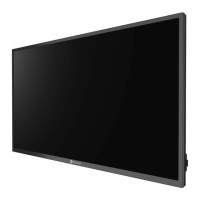
Do you have a question about the AG Neovo PM-3202 and is the answer not in the manual?
| Haze rate | 2 % |
|---|---|
| Panel type | VA |
| Pixel pitch | 0.364 x 0.364 mm |
| LED backlight | Yes |
| Display diagonal | 31.5 \ |
| Surface hardness | 3H |
| Display brightness | 350 cd/m² |
| Display technology | LCD |
| Vertical scan range | 48 - 85 Hz |
| Horizontal scan range | 28 - 92 kHz |
| Contrast ratio (typical) | 4000:1 |
| Display number of colors | 16.7 million colors |
| HDMI ports quantity | 3 |
| DisplayPorts quantity | 0 |
| Ethernet LAN data rates | 10, 100, 1000 Mbit/s |
| Ethernet LAN (RJ-45) ports | 1 |
| Storage temperature (T-T) | -20 - 60 °C |
| Operating temperature (T-T) | 0 - 40 °C |
| Storage relative humidity (H-H) | 10 - 90 % |
| Operating relative humidity (H-H) | 20 - 80 % |
| AC input voltage | 100 - 240 V |
| AC input frequency | 50 - 60 Hz |
| Power consumption (off) | 0.3 W |
| Power consumption (standby) | 0.5 W |
| Power consumption (typical) | 42 W |
| Purpose | Universal |
| Operating hours (hours/days) | 16/7 |
| Orientation | Vertical |
| Product color | Black |
| Product design | Digital signage flat panel |
| Anti-glare screen | Always gives an optimal view, even in direct sunlight. |
| Placement supported | Indoor |
| Panel mounting interface | 100 x 100, 200 x 200 mm |
| RMS rated power | 20 W |
| Number of built-in speakers | 2 |
| Cables included | AC, HDMI |
| Package depth | 139 mm |
| Package width | 818 mm |
| Package height | 547 mm |
| Package weight | 7800 g |
| Certification | FCC, CE, LVD, UKCA, WEEE, RoHS, REACH, EAC, ICES-003 (Issue 7) |
| Display depth | 65.1 mm |
|---|---|
| Display width | 726.5 mm |
| Display height | 425.4 mm |
| Display weight | 5700 g |
Regulatory compliance statement for the US market according to FCC rules.
Information regarding RoHS compliance for Ukraine.
Instructions for the proper disposal of waste electrical and electronic equipment.
Statement of compliance with Turkey's RoHS regulations.
Key considerations for safely installing the display to prevent damage or injury.
Important safety advice for operating and handling the display to avoid hazards.
Guidelines for safely cleaning and maintaining the display's appearance and function.
Advice on maintaining display performance, including burn-in prevention.
Steps for unpacking the product and verifying all included items.
Guidance on preparing the installation environment and mounting the display on a wall.
Details on VESA mounting standards and required ventilation space for heat dissipation.
Description of the display, its control panel functions, and status indicators.
Information on input/output terminals and the remote control sensor's location and use.
Comprehensive guide to using the remote control for various functions and menu navigation.
Steps to set a unique identification number for the remote control to manage multiple displays.
Instructions for battery replacement, proper handling, and optimal operating range.
Step-by-step instructions for accessing and navigating the On-Screen Display menu.
How to adjust settings, exit submenus, and close the OSD window.
A hierarchical view of all available options within the OSD menu.
Options for customizing image quality, color, brightness, and contrast.
Detailed settings for noise reduction, contrast, gamma, and input signal range.
Controls for treble, bass, balance, speaker, and audio output volume.
Settings for language, date/time, schedules, and communication interfaces.
How to program timed operations and automatic media playback from USB.
Configuring HDMI CEC, RS-232C, and LAN communication settings.
Selecting operational modes, power saving features, and auto-play behavior.
Managing button locks, display rotation, and factory reset options.
Introduction to playing photo, audio, and movie files from USB devices.
Details on compatible file formats, codecs, and USB storage requirements.
Explanation of playback modes (Manual, Auto) and specific USB media functions.
Setting up scheduled media playback based on monitor power, media insertion, or schedule.
List and explanation of potential warning messages displayed by the unit.
Supported PC resolutions, frequencies, and signal types for VGA and HDMI.
Technical details for AV input signals, including supported HDMI resolutions and frequencies.
Important safety guidelines and procedures for cleaning the display safely.
Solutions for frequently encountered problems with the display's operation.
Technical data covering panel type, size, resolution, signal input, power, and operating conditions.
Physical dimensions of the display unit and VESA mounting hole specifications.